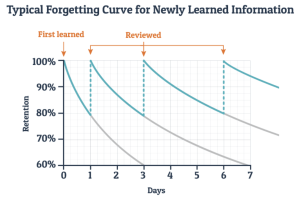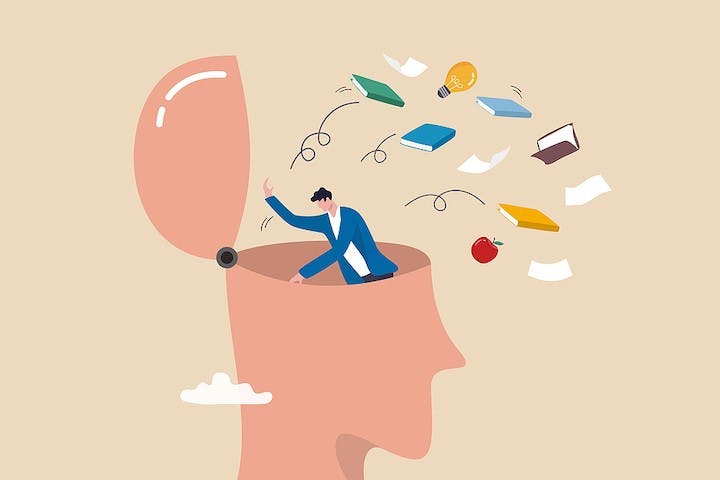If you work in learning and development, but have never come across the concept of the ‘Ebbinghaus’s Forgetting Curve’ then it’s important you do.
Named after Hermann Ebbinghaus, the 19th century German psychologist who led the way in understanding why we forget things, he theorized why learned information fades over time.


Amongst other things, he concluded that the biggest drop in retention of information occurs directly after learning. Without reviewing or reinforcing our learning, he observed that our ability to retain information plummets.
He also argued, that if we learn something new, but then make no attempt to relearn this information, we remember less and less of it as the hours, days and weeks go by.
His other observations included the fact that while we are incredibly good at remembering things we need to know (and which are vital to our survival); but that it’s easiest to remember things that have meaning. Retention of information is better when people are interested in it to start with, while the same set of information can be made more or less memorable, depending on how well it’s communicated. Even the way people feel – including stress and sleep – impacts how people retain information.
Learning (and forgetting)
All of this is important because it helps explain one of the biggest frustrations in L&D – people’s poor memory of facts they’re supposed to be learning.
Studies have suggested that humans forget as much as 50% of new information within an hour of ‘so-called’ learning it. Worse still, this increases to an average of 70% within 24 hours.
For years, learners have been seeking the silver-bullet to tackle this, and recent innovations have included online learning; and most notably games-based learning.
But gaining far more currency is ‘micro-learning’ or ‘just-in-time’ learning – where learning is cut down to its very basics, and delivered in much smaller chunks.
But is it really the savior we think it is?
Breaking down the problem
When engagement levels are low, the root cause of the problem typically tends to be poor quality content that is not designed or delivered well.
Breaking the training content down into smaller doses can quickly revive basic KPIs – such as completion rates.
But I would argue the long-term diagnosis is not good if micro-learning is used as a sticking plaster to mask underlying problems.
In order to leverage the power of micro-learning, it needs to take its rightful place in a strategy with diverse learning methods at play.
It’s only when this happens, that micro-learning can punch well above its weight.
Micro learning for maximum impact
Let’s take a step back.
When micro-learning is applied well it has major advantages.
It can help to improve retention and it has been proven to reduce the time it takes to reach competency – up to five times faster in my experience.
According to medical researcher and World Health Organistion consultant, Mrigank S Shail micro-lessons “can aid in negating the Ebbinghaus forgetting curve and can use reintroduction to keep retention at significantly higher levels.” This will, he argues speed up the learning process overall.
However, faster completion rates, though a welcome benefit from a business perspective, should not be the end goal of micro-learning content.
The end goal should be high engagement which results in better learning outcomes.
And the only way to achieve this is by designing quality content that motivates learners to practice and repeat.
Creating more motivating content
Developing high-quality, high memory retention content has long been a challenge for L&D designers.
They need to come up with creative ways to deliver the same information in a variety of engaging and fun ways so that the learner revises the content repeatedly without it becoming tedious.
In other words, one cannot simply dissect poor quality content into bite-sized pieces and expect it to work miracles.
How to improve content
If you are looking for a faster track to engaging content, help is certainly at hand with AI.
Thanks to the enormous advances in generative AI over the last year, game-based content creators have really benefited from a turbo-boost in the creative process.
For example, there are now fantastic generative AI functions available if you want to create a training solution from heavy duty, laborious text.
Let’s say, for example, you need a training solution on information security; you can upload the PDF and fire up the AI generator to come up with really workable content for micro-learning formats.
It may not be perfect, but as a first draft, it can be impressively close.
It is also transformative as a time saver – freeing designers up to focus on finessing high quality, creative and engaging content to achieve their training solution goals.
Personalization
To improve content we also need to remember that an inherent benefit of micro-learning content is its accessibility – namely that it is mobile device friendly.
This helps to personalize one’s training journey because workers can fit the training in around their life.
It is democratizing for learners because they can learn at their own pace – repeating elements that they struggle with as many times as they need to. This is something that cannot be forgotten.
Context:
“Lose the context, lose the impact”
For me, one of the biggest engagement wins is context.
While there are major benefits from smaller bursts of learning activity, any training content that fails to contextualize lessons with real-world scenarios loses impact.
Learners must be able to apply their learning to their real jobs.
This is where 3D simulations, immersive reality and virtual reality training solutions can really outperform other forms of L&D content.
Simulations allow learners to experience the context in a realistic, virtual world. This is another area of L&D that is benefiting enormously from AI – improving interactive capabilities with avatars so they feel less chat-bot-like and more engaging on a human level.
The ability to interact with realistic customers, patients and colleagues in a realistic simulated environment, where one is free to make mistakes and learn from them is a huge learning advantage.
Compare this learning experience to peer learning. When someone shows you how to do something, even if you are highly engaged and you understand the information you are receiving, you don’t know at that moment how much you will remember.
Furthermore, how do you know if you have been shown best practice in the first place? It leaves businesses open to major inconsistencies.
Realistic simulations help businesses to set the same high bar for all trainees and they can do this at scale.
They provide the learner with the opportunity to receive high quality training and practice realistic scenarios that simply would not be physically possible or cost effective in the real world.
This allows them to practice as many times as they need to in order to successfully apply their learning to their real jobs.
Micro doesn’t replace macro – it enhances it
A great L&D strategy involves planning and part of this planning should focus on how your micro-learning and macro-learning opportunities can benefit each other.
A very basic example of a learning journey would be to achieve a certain level of knowledge and practice with bite-sized learning games and simulated games before an in-person class, seminar or workshop for example.
Just as AI can save time for content creators, optimizing the creative time for human resources, micro-learning and game-based learning optimizes the time spent with an expert or coach.
It provides them with the opportunity to delve more deeply into nuanced areas and to answer more advanced questions.
Equally, micro-learning content can be used to help consolidate lessons from macro-learning sessions – allowing individuals to revise information in smaller doses.
Like so many things in a hybrid world of workplace learning, finding the right balance is part of the challenge in order to meet your strategic goals.
No single learning method can make up for the limitations of low-quality content and micro-learning is no exception.
However, when you use it to its best advantages, it can offer a healthy dose of engagement to help revive your L&D content strategy.
